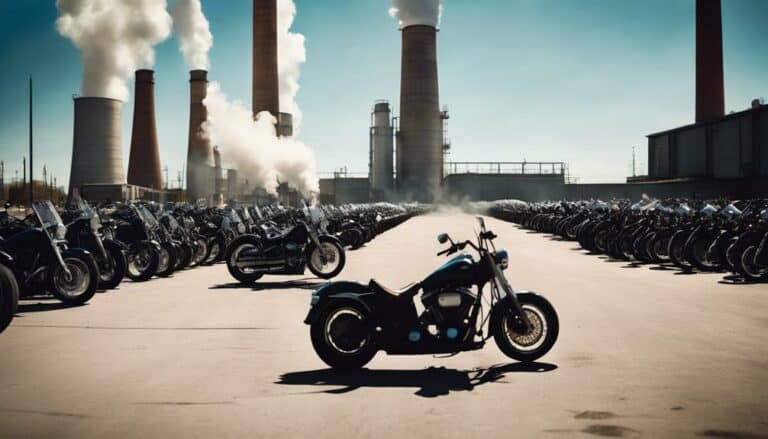Have you ever wondered where the iconic motorcycles of Harley-Davidson come to life?
The answer might not be as straightforward as you think. While the brand's origins lie in Milwaukee, Wisconsin, where its first factory was established, Harley-Davidson's manufacturing footprint has extended far beyond its hometown.
With a global presence in various countries, including the US, Brazil, and Thailand, the company strategically distributes its production to meet demand efficiently.
But what exactly happens behind the scenes at these diverse manufacturing sites? Let's uncover the intricate web of Harley-Davidson's production facilities and how they contribute to the brand's legendary status.
Key Takeaways
- Harley-Davidson manufactures motorcycles in the US, India, and Brazil.
- Components are sourced globally, with US assembly prioritized for American customers.
- Quality control measures are stringent to maintain the brand's reputation for excellence.
- Future expansion plans include optimizing manufacturing in Thailand and Brazil while balancing international production with American assembly.
Harley-Davidson Manufacturing Facilities
Harley-Davidson's manufacturing facilities, strategically positioned in Wisconsin, Pennsylvania, Missouri, India, and Brazil, serve as pivotal hubs in the brand's global production network. These facilities aren't just buildings but the heart of Harley-Davidson's production strategies, enabling the company to exceed its annual motorcycle production target of 200,000 units by the 1990s. By revamping production strategies for efficiency, Harley-Davidson has solidified its manufacturing locations as essential components of its success.
The strategic placement of these manufacturing facilities isn't a coincidence but a deliberate move to support Harley-Davidson's international sales and marketing efforts. These locations not only showcase the brand's commitment to global expansion but also play a crucial role in the economic landscape of Milwaukee and beyond. The intricate dance of production strategies within these facilities highlights Harley-Davidson's dedication to delivering quality motorcycles while maintaining a strong foothold in the global market.
Global Production Locations
Manufacturing motorcycles globally involves intricate coordination and strategic sourcing of parts from various countries to ensure efficiency and cost-effectiveness. Harley-Davidson has established production facilities in Wisconsin and assembly plants in Pennsylvania, with a focus on US assembly for American customers. The company optimizes costs through global parts sourcing, procuring components from countries like Taiwan, Japan, Italy, Germany, and Mexico.
Here are four key points to visualize Harley-Davidson's global production locations:
- Wisconsin Manufacturing: The heart of Harley-Davidson's operations, where the motorcycles are manufactured, showcasing American craftsmanship.
- Pennsylvania Assembly: The site where the parts sourced globally come together, highlighting the integration of international components.
- Global Parts Sourcing: Components sourced from Taiwan, Japan, Italy, Germany, and Mexico emphasize the multinational aspect of Harley-Davidson's supply chain.
- Strategic Expansion: The closure of the Kansas City plant in 2019 and the establishment of a new facility in Thailand demonstrate Harley-Davidson's adaptive strategies in response to changing market dynamics.
Manufacturing Process Overview
With a focus on maintaining quality control and cost-efficiency, the manufacturing process overview of Harley-Davidson motorcycles delves into the intricate coordination of global parts sourcing and assembly. Parts for Harley-Davidson motorcycles come from various countries such as Taiwan, Japan, Italy, Germany, and Mexico.
However, assembly for American customers mainly transpires in the United States to ensure stringent quality control measures are met. Different models showcase varying percentages of American-made parts contingent on the specific component. This meticulous process aims to uphold the esteemed 'Made in America' label for Harley-Davidson motorcycles distributed in the US market.
Quality Control Measures
Maintaining stringent quality control measures is essential in ensuring the safety and performance standards of Harley-Davidson motorcycles are consistently met. Harley-Davidson's commitment to quality control is evident through the implementation of rigorous testing procedures and inspection processes throughout its manufacturing facilities. Here are four key aspects of their quality control measures:
- Comprehensive Testing: Components and final products undergo thorough testing to verify adherence to safety and performance standards.
- Defect Detection: Inspection processes are in place to identify and rectify any defects or issues during the production stages.
- Continuous Improvement: Harley-Davidson actively engages in quality improvement initiatives to enhance product reliability and elevate customer satisfaction levels.
- Integrated Quality: Quality control measures are seamlessly integrated into the entire manufacturing process, ensuring high standards of craftsmanship and durability are consistently maintained.
Through these measures, Harley-Davidson upholds its reputation for producing top-quality motorcycles that meet the expectations of riders worldwide.
Future Expansion Plans
Harley-Davidson's strategic vision for future growth involves expanding production facilities in countries like Thailand and Brazil to optimize manufacturing locations and enhance competitiveness. By spreading its global production footprint, Harley-Davidson aims to manage import costs efficiently and stay competitive in the market. This expansion strategy underscores the company's commitment to balancing international manufacturing capabilities with American assembly operations.
In pursuing its future expansion plans, Harley-Davidson is focused on leveraging the strengths of its international facilities while upholding the quality and brand integrity that customers expect. By aligning its growth strategies with market demands and regulatory requirements, the company aims to navigate challenges effectively and sustain its position as a leading motorcycle manufacturer.
The decision to enhance production facilities in Thailand and Brazil reflects Harley-Davidson's proactive approach to meeting the evolving needs of its global customer base. This strategic move not only supports the company's competitiveness but also underscores its commitment to quality and innovation in the motorcycle industry.
Conclusion
In conclusion, Harley-Davidson's global manufacturing presence is a key aspect of its success. With facilities in various countries and a commitment to quality control measures, the brand ensures that its iconic motorcycles are produced with precision and care.
As Harley-Davidson continues to expand and innovate, it remains dedicated to delivering top-notch products to its customers worldwide. The theory that Harley-Davidson's manufacturing strategy is a critical driver of its growth is indeed proven true through its consistent performance and reputation in the industry.

